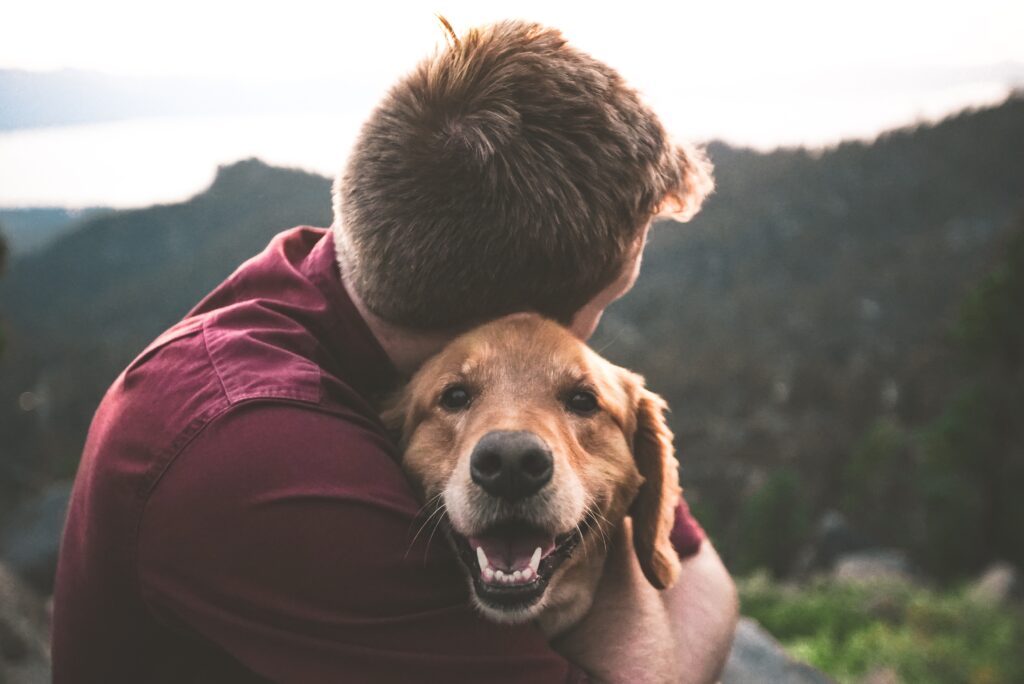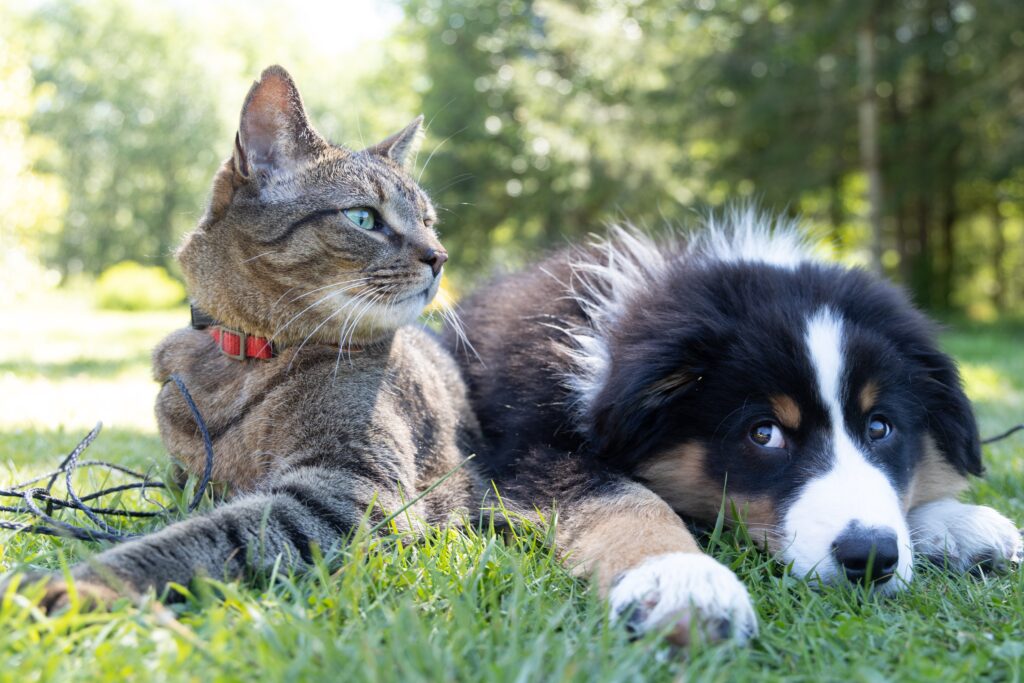It’s pretty obvious that pets can make us feel better, not just in recovery, but in general.
The most universal reason anyone gets a pet is because they want a non-judgemental, cuddly companion.
When you’re out running errands,
and you pass someone walking their dog,
and you ask to pet it,
and its tail wags like crazy,
and the owner says, “Awww, he likes you!”
There’s something about that kind of exchange, right? Comfort? A little ego boost? A little break from the grind of reality?
The list of benefits for having a pet is a long one.
But how can these already-wonderful animals specifically help people with substance use disorders?
If you’ve already done some digging around for “pets and recovery,” you’ve read a lot about animal-assisted therapy.
About how interacting with animals increases levels of oxytocin, decreases levels of cortisol, and improves mental health.
All of that is true, but there’s so much more.
Before getting into that, a quick review so you’ll have everything right here in this article.

It’s basically a patient-to-animal (and therapist) encounter with the intention of improving a patient’s emotional, physical, or cognitive well-being.
You’ve probably seen in movies where a therapy dog or cat was brought in to help a patient.
(Emotional support animals and service dogs are separate categories.)
Therapy animals can help improve the health of someone who’s terminally ill, recovering from an injury or surgery, or even battling a chronic disease/disorder.
The concept of animal-assisted therapy (AAT) isn’t new in the slightest.
There’s evidence of it being used as far back as the 1800s.
But how exactly can animal-assisted therapy be used for recovery? And what does the science say?
Well-Known Benefits of AAT in Recovery

Lower Stress Levels in a Rehabilitation Atmosphere
Going through detox, experiencing withdrawal symptoms, and being in a new, restricted environment with people you don’t know is not easy.
It can be downright overwhelming.
Because of all this, your guard is up, you’re irritable, and you miss your family and friends.
Positive human-animal interactions send signals to our brain that release oxytocin (this is often called the “love” hormone).
It’s released when we sense that we’re bonding with someone, and makes us feel more at ease.
Using animal-assisted therapy in recovery treatment is a smart move because not only does it increase the release of oxytocin, but also lowers cortisol levels (further reducing stress on a chemical level).
Improve Cardiovascular Health
This is a common theme in many posts about animal-assisted therapy and pets and recovery.
As it should be!
There is a lot of evidence to prove that having a pet can reduce heart problems.
It also isn’t a stretch to link dog ownership with improved cardiovascular health.
The physical requirements to care for a dog can easily improve an individual’s health if they are not very active before getting a dog.
People know walking improves cardiovascular health, but before having a dog, lots of people don’t have the motivation to walk every day.
What does this mean for people in recovery?
Improving cardiovascular health can help shift the focus of someone with a substance use disorder who’s beginning treatment.
Mindfulness practices are often implemented in treatment plans, and inpatients usually become more self-aware before completing any program.
Because of this newfound self-awareness, many people find their mood, ability to think clearly, and how they feel overall are greatly improved when they exercise regularly in treatment.
Fostering or adopting a pet reinforces that motivation to stay active.
Provide Companionship
Humans have been looking to animals for companionship for thousands of years.
In northern Isreal, there was a tomb with human bones and the bones of a dog or wolf puppy dating back 12,000 years ago.
It looked like the human hand was placed affectionately on the canine’s head for the burial to implicate the bond between them.
What does this mean for people in recovery?
Unfortunately, loneliness is a very common feeling for anyone just entering recovery and treatment.
Yes, you have other people going through similar situations.
Yes, you have therapists and counselors.
But going through treatment isn’t easy and can get lonesome at the drop of a hat.
Animal-assisted therapy easily helps with this by bringing non-judgemental, comforting animals into the picture for you to connect with instantly.
Lesser-Known (but arguably more inspiring) Benefits of AAT in Recovery

Improve Impulse Control
Yes, you read that right.
Animal-assisted therapy in recovery can help people with impulse control.
This is golden and almost sounds too good to be true.
If we had good impulse control, we wouldn’t be in treatment, considering treatment, or in recovery.
“So, I can hang out with a dog, cat, or horse for a bit and magically have self-control?! Sign me up!”
It’s a little more complex than that:
Interacting with therapy animals or having a pet helps you build self-control.
Horse, or equine, therapy is a perfect example.
Horses can sense and mirror a human’s energy.
Nobody wants a large animal like a horse to feel jittery or on edge, so equine therapy greatly helps residents practice self-restraint and emotion control.
Reduce Social Anxiety
Pets bridge the gap between humans all the time.
I had the same neighbors for two years before meeting them for the first time (because I found their cat on my porch).
Not only do pets and animals provide the ultimate icebreaker between strangers, but they also make us feel safer when they’re around.
What does this mean for people in recovery?
The chances of therapy providing any breakthroughs are slim to none if you can’t connect with your therapist.
Animal-assisted therapy improves the therapeutic alliance. The trust and relationship between the patient and the therapist.
In sessions where animals are present, patients in recovery feel more calm and more willing to open up about personal experiences and feelings.
They inquire to the therapist about the dog or cat, initiating conversation and feeling less anxious talking to them when the discussion flows to other topics.
Animal-assisted therapy for recovery is a very effective approach to lighten the mood and add a strong sense of positivity to any rehabilitation setting.
Improve Self-Esteem/Self-Worth
There’s no denying that substance use disorders can take you to some scary places physically and mentally.
Everyone’s rock bottom is different, but every rock bottom is the lowest any person with a substance use disorder has ever felt.
It’s a dark hole to climb out of and a lot of times…
Self-esteem is at an all-time low, and self-worth is nowhere to be found.
Animals have this mysterious way of helping us feel better about ourselves.
Something along the lines of, “Well, if this furry cutie likes me, I must have something going for me.”
What does this mean for people in recovery?
Whether a dog or cat is brought into an otherwise normal therapy session, or if it’s an equine therapy session, there’s something about human-animal interaction that makes us feel better about ourselves.
Animal-assisted therapy helps alleviate feelings of low self-worth.
Brushing a horse or cleaning its stall makes us feel useful.
Petting a cat and hearing it pur makes us feel kind and appreciated.
After completing treatment, caring for a pet creates a sense of responsibility and purpose as well, which does wonders for a person’s self-esteem.
Conclusion

Pets and recovery often work very well together. Plenty of studies provide evidence of the major benefits of having pets and participating in animal-assisted therapy.
You’re sitting on the couch in the common area watching true crime, lost in your thoughts, dreading the next therapy session, and just wishing you could have one last night to use, and then you’ll get clean for g–
“No,” you tell yourself, “it’s over. I have to do this… I can’t keep hurting the people I love.”
You want a hug, a friend, something, anything to comfort you through this dreadful thought experience.
That’s exactly what therapy animals do for people with substance use disorders who’ve just entered recovery.
What do you do with all of this information?
Look for a treatment center that implements animal-assisted therapy if it sounds like something you’re interested in.
What do you do after completing inpatient treatment?
If you can’t afford therapy or to adopt a pet right away, you can always foster or offer pet-sitting services.
If you really enjoy equine therapy but are like most people completing treatment (who don’t have the money), you could look for volunteer opportunities with local farms or horse therapy facilities.
Next Steps
Before you can reap the amazing benefits of pets and recovery or animal-assisted therapy, you have to enroll in a treatment program.
Time is the one thing we can never get back.
The sooner you decide to take action, the closer you are to the ultimate transformation (and freedom).
Please contact us if you or a loved one is suffering from a substance use disorder and needs help.